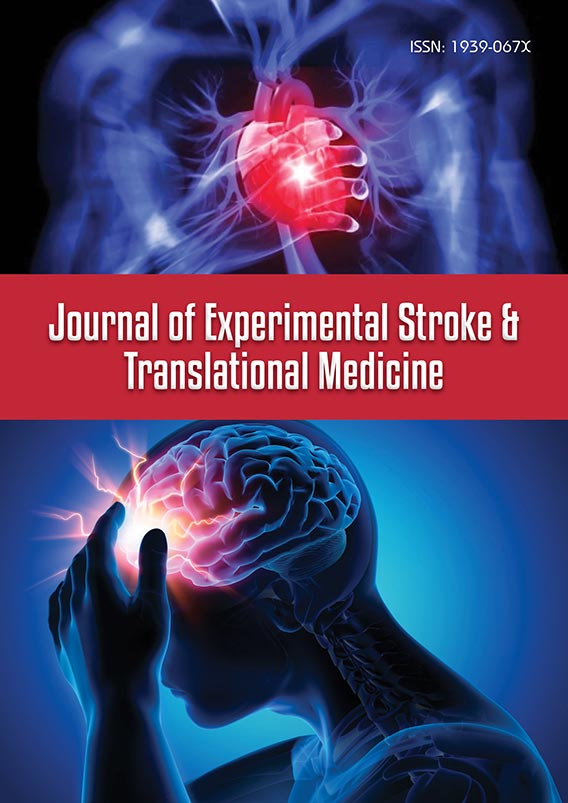Perspective - Journal of Experimental Stroke & Translational Medicine (2024) Volume 16, Issue 6
Understanding Aneurysms: Causes, Diagnosis and Treatment
- Corresponding Author:
- Joseph J Gemmete
Department of Medicine, Nkrumah University of Science and Technology, Kumasi, Ghana
E-mail: gemme@med.umich.edu
Received: 04-Nov-2024, Manuscript No. jestm-24-153511; Editor assigned: 7-Nov-2024, PreQC No. jestm-24-153511 (PQ); Reviewed: 21-Nov-2024, QC No. jestm-24-153511; Revised: 03-Dec-2024, Manuscript No. jestm-24-153511 (R); Published: 31-Dec-2024, DOI: 10.37532/jestm.2024.16(6).285-286
Introduction
An aneurysm is a localized, abnormal bulge in the wall of a blood vessel that can develop in various parts of the body. If left untreated, an aneurysm can rupture, leading to severe complications or death. While some aneurysms remain asymptomatic and stable for years, others may grow and eventually rupture, posing a significant health risk. This article delves into the types, causes, risk factors, symptoms, diagnosis and treatment options for aneurysms.
Description
Types of aneurysms
Aneurysms are classified based on their location and shape:
Cerebral aneurysm (brain aneurysm): Also known as intracranial or intracerebral aneurysms, these occur in the arteries of the brain. They can lead to subarachnoid hemorrhage if they rupture, which is a medical emergency.
Aortic aneurysm: These develop in the aorta, the largest artery in the body and are further divided into:
Abdominal Aortic Aneurysm (AAA): Occurs in the abdominal segment of the aorta.
Thoracic Aortic Aneurysm (TAA): Develops in the thoracic (chest) section of the aorta.
Peripheral aneurysm: These occur in arteries other than the aorta and brain, such as the popliteal artery behind the knee, the femoral artery in the thigh, or the carotid artery in the neck.
Ventricular aneurysm: This type forms in the wall of the heart, usually following a heart attack, where the heart muscle has been weakened.
Causes of aneurysms
Aneurysms arise due to a weakening of the blood vessel walls. Several factors contribute to this condition:
Genetic factors
Certain genetic conditions, such as Ehlers-Danlos syndrome, Marfan syndrome and polycystic kidney disease, increase the risk of developing aneurysms.
Atherosclerosis: The buildup of plaque in the arteries weakens the arterial walls, making them more prone to bulging and aneurysm formation.
Hypertension (High blood pressure): Chronic high blood pressure exerts excessive pressure on artery walls, contributing to their weakening over time.
Trauma: Blunt or penetrating injuries can cause localized damage to blood vessel walls, leading to aneurysms.
Infections: Certain infections, such as syphilis or bacterial endocarditis, can weaken blood vessels and result in aneurysm formation.
Smoking: Smoking is a significant risk factor for the development and progression of aneurysms due to its detrimental effects on vascular health.
Risk factors
Several factors increase the likelihood of developing an aneurysm:
Age: Aneurysms are more common in individuals over the age of 60.
Gender: Men are at a higher risk of developing aortic aneurysms, while women have a higher risk of brain aneurysms.
Family history: A family history of aneurysms increases the risk.
Lifestyle factors: Smoking, alcohol consumption and a sedentary lifestyle contribute to the risk.
Symptoms of aneurysms
Many aneurysms are asymptomatic and are discovered incidentally during imaging studies for other conditions. However, larger aneurysms or those that are about to rupture may present with the following symptoms:
Cerebral aneurysm symptoms
Severe, sudden headache (often described as the “worst headache of one’s life”)
• Nausea and vomiting
• Neck stiffness
• Blurred or double vision
• Sensitivity to light
• Loss of consciousness in severe cases
Abdominal aortic aneurysm symptoms
• Deep, persistent pain in the abdomen or back
• A pulsating sensation near the navel
• Sudden, severe abdominal or back pain indicating rupture
Thoracic aortic aneurysm symptoms
• Chest pain or back pain
• Difficulty breathing
• Hoarseness
• Coughing
Peripheral aneurysm symptoms
• Pain or swelling in the affected limb
• A palpable pulsating mass
• Reduced blood flow to the limb, causing coldness or numbness
Diagnosis of aneurysms
Accurate diagnosis of an aneurysm often involves a combination of physical examinations and imaging studies:
Ultrasound: A non-invasive and widely used technique to detect abdominal and peripheral aneurysms.
Computed Tomography (CT) scan: CT angiography provides detailed images of blood vessels and is useful for detecting aortic and cerebral aneurysms.
Magnetic Resonance Imaging (MRI): MRI and MR angiography offer high-resolution images of blood vessels without using ionizing radiation.
Cerebral angiography: This invasive procedure involves injecting contrast dye into the arteries to visualize cerebral aneurysms.
Prevention of aneurysms
While not all aneurysms can be prevented, certain measures can reduce the risk:
Control blood pressure: Maintain healthy blood pressure levels through diet, exercise and medication.
Quit smoking: Smoking cessation significantly reduces the risk of aneurysms.
Healthy diet: A diet low in saturated fats and high in fruits, vegetables and whole grains supports vascular health.
Conclusion
Aneurysms are a potentially life-threatening condition that requires early detection and appropriate management. Advances in diagnostic imaging and treatment options have significantly improved outcomes for patients with aneurysms. By understanding the risk factors, symptoms and treatment options, individuals can take proactive steps to reduce their risk and seek timely medical attention when necessary.

